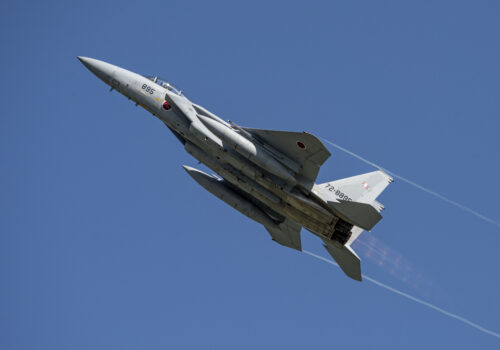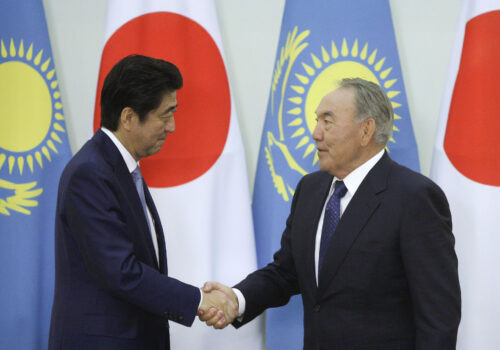How will Japan’s ‘Iron Lady’ approach foreign policy?
On October 21, Takaichi Sanae made history as the first female prime minister of Japan. As a protégé of the late former Prime Minister Abe Shinzo, her political career up to this point has been markedly conservative domestically and hawkish globally. There are certainly benefits to riding the coattails of her mentor, particularly when it comes to cultivating a personal relationship with US President Donald Trump, which Abe did successfully. However, she will need to be selective in which foreign policies she sustains from Abe’s legacy to best address a fundamentally different global and domestic political environment. Since Russia’s full-scale invasion of Ukraine in 2022, Moscow, Pyongyang, and Beijing have ramped up their military cooperation through joint exercises, provisions of weapons and munitions, and dual-use technology sharing.
Takaichi has emblazoned her tenure with the brand “Japan is Back,” recognizing the need for Japan to reassert itself as an economic and security leader in the Indo-Pacific. To avoid being another short-term prime minister in Japan’s current revolving-door era, she should pursue three key agenda items.
First, in this unprecedented security environment, she must uphold her vow to build up Japan’s defense capabilities. Second, she will need to work to build strong relations with South Korea. Since Washington is indicating it will scale back its presence globally, Tokyo and Seoul will need to set aside their differences to focus on addressing shared security threats in the region. Third, she must shed light on China’s aggressive activities and garner support from likeminded Indo-Pacific and European partners to counter them. This should include raising awareness of Beijing’s multi-domain maneuvers in the Taiwan Strait and gray-zone tactics in the South China Sea, which the People’s Liberation Army is supporting as it rapidly modernizes.
Investing in Japan’s defense
Trump and Takaichi’s inaugural summit in Tokyo on October 28 went off without a hitch. Abe, Takaichi’s political mentor and one of Trump’s closest foreign allies in his first term, teed her up for success. In an increasingly divided Liberal Democratic Party (LDP), Takaichi has been steadfast in her allegiance to Abe’s conservative camp, even earning his endorsement for LDP leadership in a previously unsuccessful bid in 2021. As a symbolic gesture, she hosted Trump at the Akasaka Palace, the last location at which Abe hosted the US president before the Japanese prime minister’s untimely death. She leaned heavily into Abe’s legacy and the pair’s shared love of golf, gifting Trump the late prime minister’s personal putter encased in glass. But she recognizes that such gestures alone will not be sufficient. Takaichi arrived at the negotiating table armed with concrete evidence that Japan is ready to take on a more assertive role in deterring ongoing and emerging threats in the Indo-Pacific theater.
In her first week as prime minister, Takaichi announced plans to boost Japanese defense spending to 2 percent of gross domestic product by the spring of 2026, accelerating the previous timeline to do so by two years. In line with her predecessors, Takaichi is seeking to bolster defense capabilities such as counterstrike missiles while enhancing partnerships with like-minded countries to deter shared regional threats. To meet evolving modern warfare challenges, she has prioritized developing and acquiring advanced dual-use defense technologies, such as origami drones—innovative unmanned aerial vehicles (UAVs) inspired by traditional paper folding for collision resilience and self-folding capabilities.
Given her background in Abe’s conservative wing of the LDP, she is not expected to shed her hawkish views on China as prime minister. In April, she met with Taiwanese President Lai Ching-te and even called for a “quasi-security alliance” with Taipei, despite Tokyo not even having formal diplomatic relations with the island. Chinese President Xi Jinping has certainly taken note of this, and he has noticeably so far refrained from congratulating Takaichi on her election win.
Building stronger South Korea ties
Beijing is unwavering in its mission to unilaterally change the regional status quo by coercive force. It is therefore imperative that Washington and Tokyo strengthen their supply chains of critical minerals and rare earths, which are essential components of advanced technologies and modern infrastructure bolstering the US-Japan security alliance. To reduce reliance on China in these key industries, Trump and Takaichi launched a new bilateral framework for “Securing the Supply of Critical Minerals and Rare Earths through Mining and Processing.” This builds on efforts last month, when Trump and then Prime Minister Ishiba Shigeru signed a major trade agreement for Japan to invest $550 billion into the US economy. Seeking to build on this momentum, Trump and Takaichi this week identified key sectors that Japanese companies will direct this investment toward: manufacturing and logistics, critical minerals, artificial intelligence (AI), critical energy, and electronics.
Although strengthening the US-Japan defense infrastructure will be crucial to safeguarding Indo-Pacific security, Washington and Tokyo cannot do this alone. At a time when the Trump administration’s foreign policy is largely unpredictable, South Korean President Lee Jae-myung and Takaichi must put historical grievances aside and prioritize shared regional challenges. Historically, Washington has spearheaded trilateral cooperation given the instability of South Korea-Japan bilateral relations depending on who is in power, with tensions at a peak during the years when Abe and former South Korean President Moon Jae-in were in office. But in this geopolitical climate, Tokyo and Seoul cannot afford to let relations sour.
The two countries are off to a promising start. Lee was one of the first world leaders to congratulate Takaichi on becoming prime minister. She reciprocated by highlighting South Korea as an “important neighbor” at her first press conference, even adding a personal touch to express her love of Korean cosmetics, dramas, and seasoned seaweed. Lee and Takaichi met in Gyeongju, South Korea on the margins of the Asia-Pacific Economic Cooperation forum.
At the same time, South Koreans remain understandably skeptical of how long friendly relations will persist. As recently as last year, Takaichi visited the Yasukuni Shrine, which memorializes Class-A war criminals from World War II—a practice that raises the ire of Seoul and Beijing. Now as the leader of her country, any actions she takes will be dissected under a microscope. It is prudent that she avoid stepping foot in Yasukuni Shrine while holding the mantle of prime minister.
Bolstering Indo-Pacific security with ASEAN partners
The Indo-Pacific region has no shortage of complicated dynamics that heads of state must carefully navigate. On October 26, Takaichi conducted her diplomatic debut at the Association of Southeast Asian Nations (ASEAN)–Japan Summit. She adeptly walked a fine diplomatic line, calling attention to grave security threats facing the region without forcing ASEAN members to make a zero-sum decision between Washington and Beijing. Southeast Asia is a region of strategic importance for Japanese national and economic security. An especially effective aspect of Japan’s ASEAN strategy is treating member states as equal partners rather than making demands of them. In that vein, at the summit, she launched the Japan-ASEAN AI Co-creation Initiative, which would enable research exchanges in cutting-edge fields such as quantum technology and semiconductors, as well as training and governance frameworks to develop ASEAN’s large language models. By proposing mutually beneficial advancements in high-tech products, Japan and ASEAN member states can avoid becoming overly dependent on either Beijing or Washington in an era of deep US-China rivalry.
During the summit, Takaichi stated that coercive activities in the South and East China seas have caused serious concern without directly mentioning Beijing, given her understanding that ASEAN member states are hesitant to sever ties with China, on which their economic growth is heavily dependent.
Ultimately, the prime minister needs to make rational assessments of her country’s competitive advantages and use them as levers for shaping the Indo-Pacific environment to its benefit. She has already pursued this strategy by increasing Official Security Assistance (OSA) to Southeast Asia. Launched in 2023, this military aid program aims to strengthen defense capabilities of like-minded countries in the region to create a more favorable security environment for Tokyo. With OSA, Japan leverages areas that it leads in, such as maritime security and disaster response, to provide member states (including the Philippines, Malaysia, and Indonesia) with grants for military equipment vital for countering People’s Liberation Army Navy incursions.
Takaichi has the unenviable task of balancing the demands of warring factions in her party, forming shaky coalitions with other parties, and remaining in the good graces of the Japanese public. She must accomplish all this while also aiming to match Abe’s ability to maintain US security guarantees in the Indo-Pacific and fend off Trump’s punitive economic measures. With Washington looking inward and rethinking its traditional allegiances, Tokyo—alongside trusted neighbors—must revitalize its leadership role in the Indo-Pacific and step outside of the shadow cast by Washington.
Kyoko Imai is the associate director for the Indo-Pacific Security Initiative of the Atlantic Council’s Scowcroft Center for Strategy and Security.
Further reading
Mon, Sep 22, 2025
Why has Japan deployed fighter jets to NATO bases in the US, Canada, and Europe?
New Atlanticist By
As part of Operation Atlantic Eagles, Tokyo has sent four F-15 fighter jets and four additional military aircraft to the United States, Canada, the United Kingdom, and Germany.
Fri, Aug 15, 2025
The future of US and Japanese engagement with Central Asia
Issue Brief By Kyoko Imai
Situated between China and Russia, and with an abundance of vital natural resources, Central Asia is an area of strategic interest for Tokyo and Washington. Beijing and Moscow currently enjoy overwhelming political, economic, and cultural influence, which limits other countries’ ability to constructively shape the region. Some friction has emerged between the two authoritarian powers as post-Soviet dominance over Central Asia erodes and Chinese economic influence takes its place.
Mon, Jun 9, 2025
China is carrying out ‘dress rehearsals’ to take Taiwan. Here’s how the US should respond.
New Atlanticist By Adam Kozloski
With China escalating its operational tempo in the Taiwan Strait, the United States must enhance its forward defense posture in the Indo-Pacific.
Image: 30 OCT 2025 - Gimhae, South Korea: Japanese Prime Minister Sanae Takaichi, arrives at Gimhae Air Base in Gimhae, South Korea on October 30, 2025. Sanae Takaichi is in South Korea for the APEC meetings, following an appearance at the ASEAN summit. (Photo by: Yonhap News/POOL/Handout via Sipa USA via Reuters Connect.)



